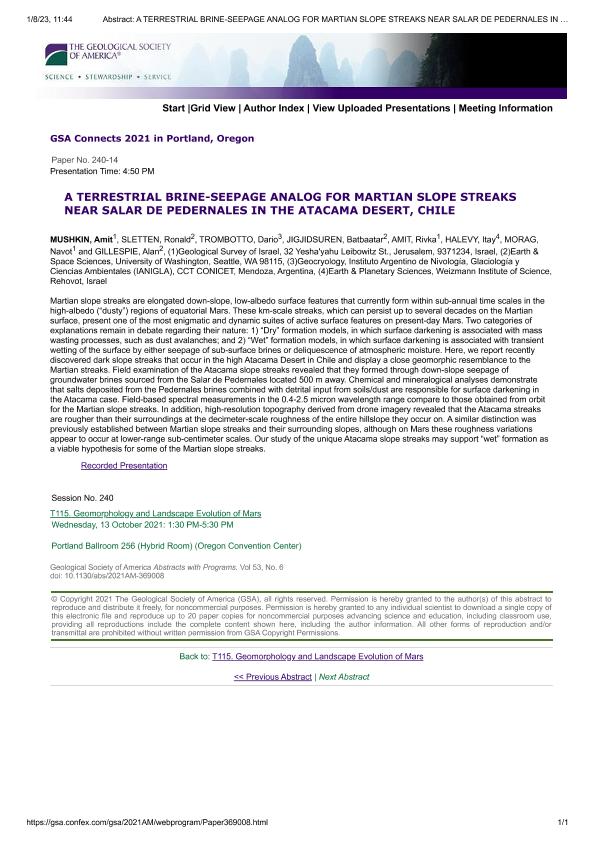Evento
A terrestrial brine-seepage analog for Martian slope streaks near Salar de Pedernales in the Atacama Desert, Chile
Mushkin, Amit; Sletten, Ronal; Trombotto, Dario Tomas ; Jigjidsurengiin, Batbaatar; Amit, Rivka; Halevy, Itay; Morag, Navot; Gillespie, Alan R.
; Jigjidsurengiin, Batbaatar; Amit, Rivka; Halevy, Itay; Morag, Navot; Gillespie, Alan R.
 ; Jigjidsurengiin, Batbaatar; Amit, Rivka; Halevy, Itay; Morag, Navot; Gillespie, Alan R.
; Jigjidsurengiin, Batbaatar; Amit, Rivka; Halevy, Itay; Morag, Navot; Gillespie, Alan R.
Tipo del evento:
Congreso
Nombre del evento:
The Geological Society of America: Connects 2021
Fecha del evento:
10/10/2021
Institución Organizadora:
The Geological Society of America;
Título de la revista:
Geological Society of America Abstracts with Programs
Editorial:
The Geological Society of America
Idioma:
Inglés
Clasificación temática:
Resumen
Martian slope streaks are elongated down-slope, low-albedo surface features that currently form within sub-annual time scales in the high-albedo (“dusty”) regions of equatorial Mars. These km-scale streaks, which can persist up to several decades on the Martian surface, present one of the most enigmatic and dynamic suites of active surface features on present-day Mars. Two categories of explanations remain in debate regarding their nature: 1) “Dry” formation models, in which surface darkening is associated with mass wasting processes, such as dust avalanches; and 2) “Wet” formation models, in which surface darkening is associated with transient wetting of the surface by either seepage of sub-surface brines or deliquescence of atmospheric moisture. Here, we report recently discovered dark slope streaks that occur in the high Atacama Desert in Chile and display a close geomorphic resemblance to the Martian streaks. Field examination of the Atacama slope streaks revealed that they formed through down-slope seepage of groundwater brines sourced from the Salar de Pedernales located 500 m away. Chemical and mineralogical analyses demonstrate that salts deposited from the Pedernales brines combined with detrital input from soils/dust are responsible for surface darkening in the Atacama case. Field-based spectral measurements in the 0.4-2.5 micron wavelength range compare to those obtained from orbit for the Martian slope streaks. In addition, high-resolution topography derived from drone imagery revealed that the Atacama streaks are rougher than their surroundings at the decimeter-scale roughness of the entire hillslope they occur on. A similar distinction was previously established between Martian slope streaks and their surrounding slopes, although on Mars these roughness variations appear to occur at lower-range sub-centimeter scales. Our study of the unique Atacama slope streaks may support “wet” formation as a viable hypothesis for some of the Martian slope streaks.
Palabras clave:
Martian slope streaks
,
Atacama
,
Desert
,
Salar de pedernales
Archivos asociados
Licencia
Identificadores
Colecciones
Eventos(IANIGLA)
Eventos de INST. ARG. DE NIVOLOGIA, GLACIOLOGIA Y CS. AMBIENT
Eventos de INST. ARG. DE NIVOLOGIA, GLACIOLOGIA Y CS. AMBIENT
Citación
A terrestrial brine-seepage analog for Martian slope streaks near Salar de Pedernales in the Atacama Desert, Chile; The Geological Society of America: Connects 2021; Oregon; Estados Unidos; 2021; 1-1
Compartir
Altmétricas



